The Dark Side of Beauty Standards in Helter Skelter: A semiotic analysis
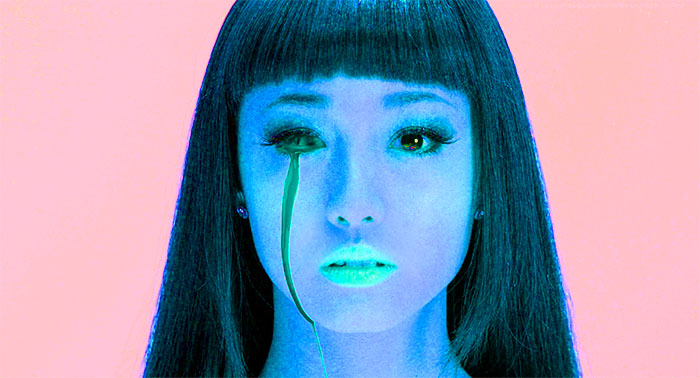
Beauty standards are culturally rooted and socially perceived as the criteria by which a person can be judged in terms of physical attractiveness. Different cultural groups and even individuals themselves have their own definition of beauty standards. They consist of specific characteristics that the perceiver expects themselves and/or others to have or follow, resulting in a particular body image. For example, Asians are expected to have a petite body size with a clear skin, glowing soft hair, and a cute face with natural make-up. In Arab societies, on the other hand, feminine beauty preferences consist of a mature face with a considerable amount of make-up and a female shaped body that is entirely waxed.
This article is an attempt to explore the negative implications that these standards can have upon people as depicted through the Japanese film Helter Skelter. The adopted method of analysis is a semiotic approach in that symbols and signs are examined to focus on their deeper significations. This will hopefully bring attention to the dark side of beauty standards in the film and beyond. Thus, it will focus on women and the pressure they undergo to have a particular body image especially in the fashion industry because the film under analysis draws our attention to this particular gender and dark vision on beauty.
A brief introduction to the film Helter Skelter
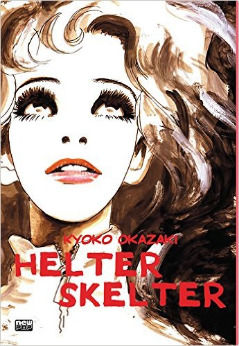
The movie Helter Skelter was directed by Mika Ninagawa and released in 2012. The actress Erika Sawajiri plays the starring role in it. It is based on a manga that Kyoko Okazaki authored and published between 1995 and 1996. The story involves the main character Ririko who struggles to remain young and beautiful in the modeling industry after several cosmetic surgeries. As a result, she refuses to be replaced after getting hooked on fame and attention, which gradually drives her to insanity and immoral actions. I will apply the theory of semiotics as introduced by De Saussure to intricately investigate the signs that contribute to debunking the ugly perceptions of beauty standards, especially in the modeling world. I will then interpret the binary conceptual relationships to provide an explanation of the film’s hidden messages, i.e. invalidating the belief that beauty standards are more important than they are supposed to be.
What is semiotics?
Semiotics is the study of signs and the relationship between them. It was introduced by Ferdinand De Saussure and Charles Sanders Pierce who both interpreted the inner workings of signs differently. De Saussure maintains that in the world of signs, there is a duality of the signifier which is any element that exists in reality like sounds, images, objects, etc., and the signified which is the abstract representation of the described element. According to De Saussure, these two concepts cannot exist separately as one cannot stand without the other.
“Saussure’s theory is considered as the proponent to the thought that “language does not reflect reality but rather constructs it” because we do not only use language or give meaning to anything that exists in the world of reality, but also to anything that does not exist in it” 1
Conversely, Pierce theorizes that the system of signs relies on a three-dimensional relationship between icons, symbols and indexes. Icons are signs that physically resemble the element being represented. For example, a road sign of a bus indicating a bus station. Indexes have a physical connection with the signified but not as close as icons. For instance, a skull with two bones crossed behind it signifying danger. Symbols, on the other hand, have no physical relation between the signifier and signified. Cultural groups have to agree that the sign refers to something like the well-known peace symbol of the circle with three lines inside it.
The Figure below displays and summarizes the theory of semiotics along with its basic concepts as presented by Pierce and De Saussure.
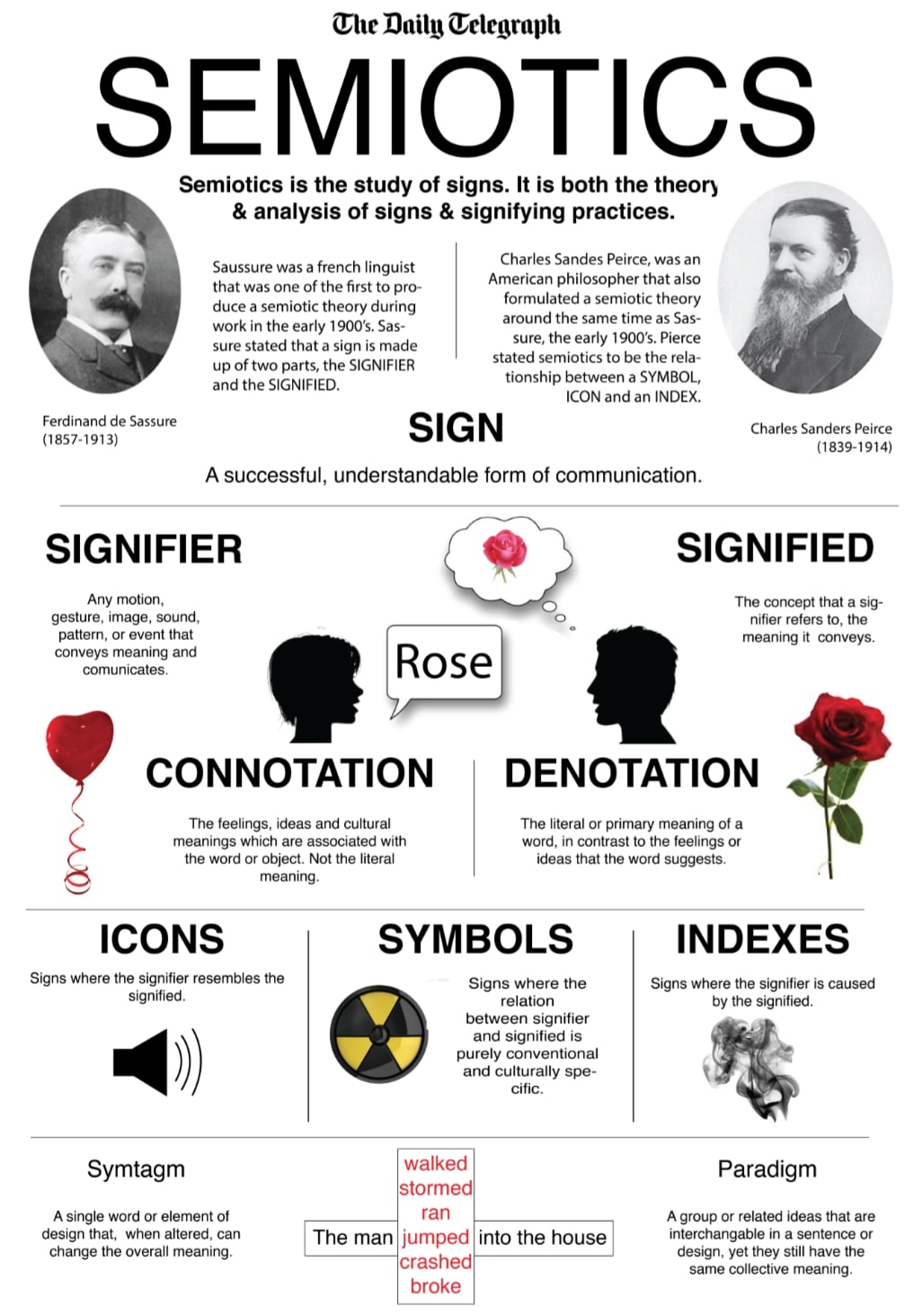
De Saussure asserts that even though it has been agreed that signs mean something specific, they still have an arbitrary property that allows them to have different and multiple meanings according to the interpretation the interpreter assigns to them. The figure above hints at this proposition through the concepts connotation and denotation. In this sense, Yakin and Totu maintain that:
“the semiotic approaches and concepts that [Pierce and De Saussure] introduced have received widespread coverage and are often used as references in various fields and disciplines of thought that are not only narrowed to the field of philosophy and linguistics, but also arts & literature, such as music, theatre, movies and text analysis as well as communication, advertising, anthropology, psychology, archeology, architecture, mathematics and so on.”
This leads to narrow down the scope on film semiotics, which is an important concept to consider when analyzing movies in a semiotic sense.
What is film semiotics?
According to Christian Metz, “the study of connotation brings us closer to the notion of the cinema as an art.” This means that Metz, who has been studying cinema in a semiotic context, refers to De Saussure’s concept of connotation to relate it to the analysis of signs in films. Before proceeding to the semiotic analysis of the movie, it is mandatory to introduce Roland Barthe’s five systems of codes to be considered in the film’s semiotic analysis:
- The engimatic code is a device used to bring the audience’s attention to the mysterious aspect of the plot, making them ask questions about the characters, the way the narrative is going to develop, the end of the story, etc.
- The connotative code relates to all the signs that bring meaning to characters like their verbal and non-verbal language. This code also includes assigning ideas to settings like the clothing, the place, the objects, the music, etc.
- The action code suggests that signs are a part of “a pattern of actions” like how posters allude to the genre of the movie.
- The symbolic code is the way the text is organized into binary properties to describe the relationship between characters such as villain vs. hero or master vs. slave.
- The cultural code evokes different responses in the viewer according to the culture they belong to. 3 For instance, homophobic communities perceive a love story between gay men displayed in a film poster positively while homophobic groups view it negatively.
The analysis of the film Helter Skelter
The poster
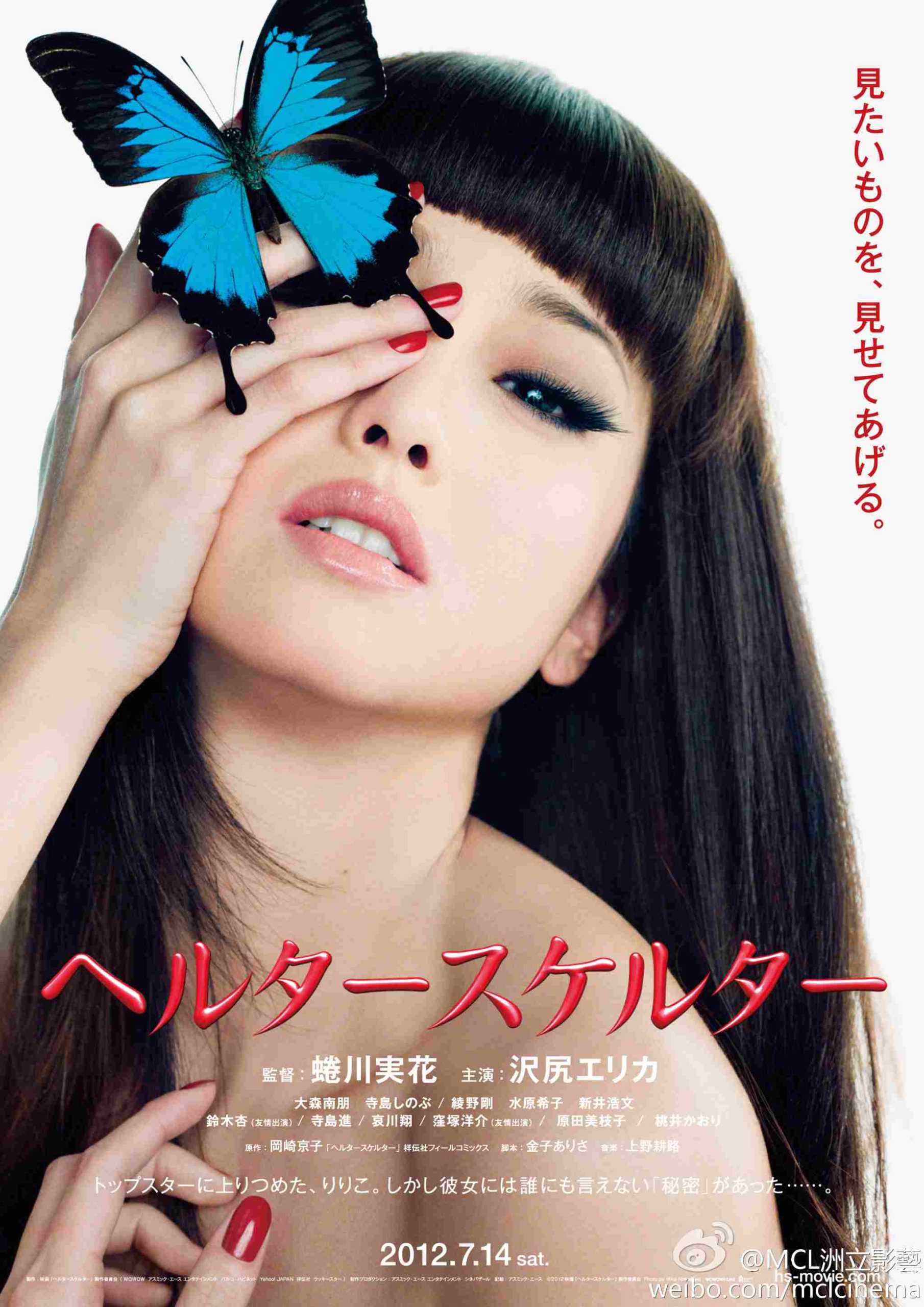
The first thing that grabs our attention in the poster is the picture which portrays the protagonist as a beautiful and confident woman. She is hiding her right eye with her hand on which there is a blue butterfly. This invites the audience to wonder why the woman is maintaining this position and why there is a butterfly.
The color is also of great significance in that it alludes to the film’s mood. For example, the white background in this context suggests a cold and clinical atmosphere. 4This corresponds to the idea of a beauty clinic that is indifferent towards the patients and only cares about making money out of their desperate desire to fit the sociocultural beauty standards.
What is also noteworthy is the color of the movie title which is red and looks like blood indicating danger and threat. The font style is bold and has some sort of shadowy effects making it belong to the thriller genre. The expression Helter Skelter means that something is done hurriedly and in a disorganized fashion. This hints at the chaotic atmosphere of the movie. Even if one is unaware of the narrative of the film, they would still anticipate intensely dramatic events from the title’s meaning.
The text in the poster further draws the viewer’s attention to check the movie, which reinforces Roland Barthe’s enigmatic code. In fact, the vertical text in red in the original poster is read in Japanese as “mitai mono o misete ageru” that literally translates as The thing you want to see, I show to give to you. If we look deeply at the defying look of the main character in the poster whilst reading this caption, we can assume that this is her monologue and that she is determined to show something to others that they would give it positive attention. Furthermore, the informal language of the Japanese statement, which is evident through the word “ageru,” implies an intimate conversation between the main character and her audience. The thing she wants to show can be the butterfly that is a sign of transformation, which can be related to beauty as the theme of the film suggests.
There is another text shown horizantally and in white that may seem irrelevant as it is not as clear as the vertical text, but it certainly conveys more clues about the movie’s plot. It is read in Japanese as “Top star ni nobori Tsumeta, Shikashi kanojo ni wa dare ni mo iueunai “Himitsu” ga atta” and is translated in English to mean Climbed up to be a top star, however she can’t tell anyone there was a “secret”. This is another enigmatic code to raise the audience’s curiosity in relation to what this secret can be about. Besides, the deliberate use of inverted commas for the word secret shows that it is a heavy and dark one. The Japanese language is overly context sensitive and the poster is an example of semiosis to refer to the Japanese cultural context.
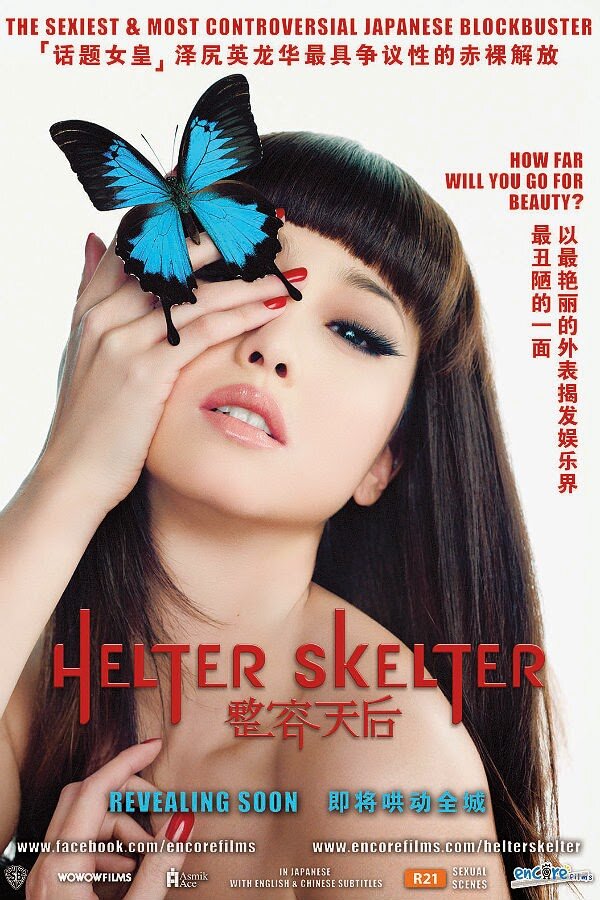
The Chinese poster gets the audience closer to the central idea of the film through the English caption “How far will you go for beauty?” which is a question that evokes a debate on whether beauty is important or not. This can also help predict that there is a war on beauty in the film. It signifies that the protagonist wants to show beauty to the public eye, which is what they expect to see from her since she is a “top star.“ There is also the caption “The sexiest and most controversial Japanese blockbuster” showcasing the success the movie has reached particularly by using the phrase “blockbuster.” It indicates that the film is appealing and a source of controversy about a precise debatable topic on beauty.
Metaphors
There are multiple metaphors in this film that help portray the negative outcomes of obsessively pursuing beauty. Object metaphors are real and concrete because the audience can visualize them in the movie as real objects. Image metaphors, on the other hand, are conceptual and abstract in nature since the characters simply state them as ideas.
Object metaphors
To start with object metaphors, the beauty clinic is a place where patients seek to transform their body into one that is befitting of the sociocultural beauty standards. Yet, this clinic is different in that it uses illegal drugs and baby organs in the surgeries which is why it is under police investigation. This place alludes to the media that manipulates people, especially women, to fit the beauty standards that the culture they are born in imposes. In fact, the doctors who represent the members promoting this belief inject and drug the weak patients with ideas that physical beauty is the essence of happiness. During the surgery, the head doctor tells Ririko, the main character, how she used to be unnoticed and ugly assimilating her to “a lump of meat” and how thanks to her treatment, she could become happy. This scene is a clear indication that the beauty clinic is selling superficial beliefs about beauty and making those easily influenced to get a hot body enslaved by the idea that without physical beauty, there is no happiness.
Another noticeable object metaphor is the clock which denotes that Ririko’s time is over. Actually, the cosmetic operation she underwent is temporary and the drugs that help maintain her beauty are exhorbitant and unhealthy. This is why it is a given that she will sooner or later lose this power she has and that she uses to gain the public’s attention. At the very beginning of the film, Ririko says “there is a sound inside me. “tick tock tick tock” it says, telling me to hurry, the sound inside me that says something will soon be over.” The sound is obviously an allusion to a clock indicating that Ririko’s time is almost put to an end. By the end of the film, she is in total despair and is deliberately portrayed in a dramatic scene under the rainfall in the street. She “coincidentally” encounters a huge clock displayed in a store showing that her time is indeed finished. If we look closely in this scene, we would remark that there are some dead looking butterflies scattered on the ground of the showcase along with the clocks and the mirrors.
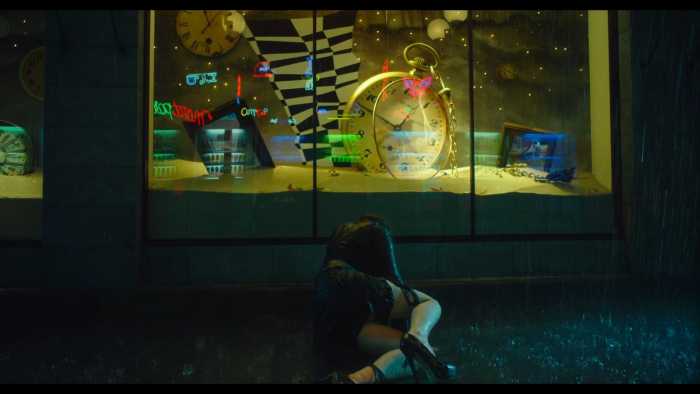
The butterflies are also object metaphors in the film designating that it is time to transform and give up superficial desires. Indeed, the butterfly is a symbol of spiritual change in many cultures. Ririko has been frequently surrounded by butterflies in the film and even in the poster. As a matter of fact, she has a small tattoo of a butterfly on her foot, there is a frame and small showcases of butterflies hung on the wall of her house, and after a lot of drug consumption, she has visual hallucinations of flying butterflies. These signs are deliberately shown to Ririko to let her know that it is time for her to let go of these superficial endeavors that only bring temporary comfort and to go beyond that through a deep spiritual transformation. The scene of the dead butterflies in the showcase with the clock delineates her persistence to preserve her artificial beauty and her refusal that it is provisional, which slowly brings her to her tragic downfall.
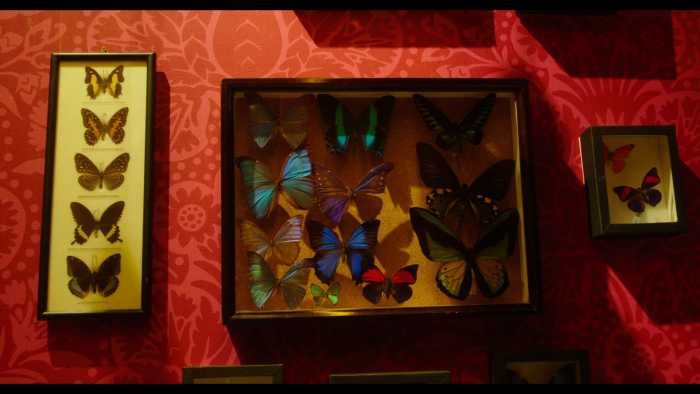
The house can be considered as another object metaphor that embodies Ririko’s obsessive and compulsive attitude towards her altered image, i.e. her post cosmetic surgery body. This is made obvious through the frames of her own pictures hung on the wall along with a giant picture of her modeling. This mirrors her narcissistic beliefs of herself that she feeds through the new body image she has. In fact, while talking to her sister, she assimilates beauty to strength which confirms that she believes that beauty gives her power. For her, without a beautiful body, one is completely weak and desperate. The style of the house further reinforces Ririko’s egocentric persona. As shown in the pictures below, it is arranged in a royal and grandiose fashion which unveils her overproud beliefs of herself. However, this is only an impression as that is how Ririko wants to look like and feel like but in relaity, she is vulnerable, insecure, and unconfident. For this reason, she needs a hot body and an extravagantly appealing house from the royalty to cover her real emotional issues.

Image metaphors
Image metaphors in this film are mentally depicted through the speech of the characters. The detective is the one who mostly uses these types of metaphors. For instance, while Ririko is contemplating her face and body in the mirror, the detective utters these words: “pretty from the outside but like a fruit that bugs have eaten from within.” Here, the image of the fruit is associated with Ririko’s character. Through this quote, the audience can tell that something is wrong with her and that she may look beautiful on the surface but this beauty is covering an ugliness in her mind or soul. The bugs eating her inside signify this ugliness. The oxymoronic dichotomy of beauty and ugliness is painted through the image of the fruit and bugs.
In the same line of thought, the detective goes on to describe Ririko’s behavior while seeing her on TV and he says: “Her beauty is a montage of images. The sum total of our desires. She beats her wings the way we want even if she can only do that by losing her own feathers.” This means that human desires manipulate the model to show them beauty the way they want to see it. The detective, in this context, implicitly assimilates her to the image of a bird that flaps its wings by undergoing cosmetic surgeries to satisfy social desires. To maintain this reality, she can go as far as losing her feathers which is a painful process. The feathers metaphor can be an image and object metaphor at the same time because it is both uttered at the beginning of the film and visualized as an object at the end. This aligns with the macabre eye stabbing scene during which Ririko falls in front of a crowd of journalists with red feathers gently falling on her. This paints her as a legend who dares to lose her own “feathers” so that she keeps winning the heart of her fans.
Another image metaphor that the detective employs to describe Ririko and her likes is the tiger lily. These women enslaved by the idea of having to fit the beauty standards are like the flower tiger lily delineating pride, which entails that this category of women mostly show their confidence and pride through the power of physical beauty. They are unconscious of what they are doing because society compelled them to stick to the beauty standards dictated on them. There is no harm and it is even recommended to take care of oneself to look beautiful and feel confident and happy, but it is unhealthy to make physical beauty the only component that brings ultimate happiness, which is a trap that Ririko and many women sadly fall into.
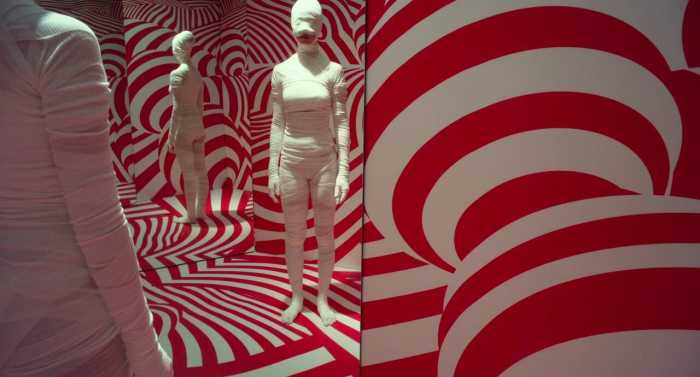
Audiovisual elements
The cinematography of the film includes a plethora of visual elements but we will mainly pay attention to the camera angles and the lighting as the primary on-screen visual features. The camera angles are always either focusing on Ririko’s face or whole body. This deliberate choice of angles brings the audience’s attention to her superficial beauty. The most significant camera angle that is worth mentioning is the one shot from a superior position in the eye stabbing scene to show Ririko as an inferior character. This delineates that her time has come and that in reality she is weak and frail. However, she does not give up by stabbing her own eye to show that she will never allow for her time to be over, and the red feathers falling on her meanwhile connote her torment that is intensified by being an object of contemplation to the world. Indeed, like the detective previously implied, she is similar to a bird who keeps beating her feathers until she loses them for the sake of the public’s desires. She is ready to go through excruciating situations just to preserve her beautiful body and maintain the attention she receives from her audience.
The lighting around Ririko is also very symbolic and it depicts her mental state. In this respect, the color red is predominant around her signifying anger, power, and danger in filmmaking. In fact, Ririko feels powerful with the beauty she earned and this makes her dangerous because without this beauty, she feels angry and lost which eventually leads to her own dismay. The red color is also contrasted with the yellow color in lighting. In cinema, yellow can signify insanity and in general terms, it can allude to jealousy. Insanity and jealousy are emotional states that Ririko goes through throughout her modeling journey. She is jealous of the other models and particularly the ones competing with her. Attempting to ruin their faces by sending her manager to do it certainly makes her insane along with other behavioral issues that will be discussed shortly.


Another worth mentioning movie audio characteristic is the soundtracks which add further meaning to the theme of the film and have symbolic implications. While displaying the title of the movie on the screen, a creepy and chilling soundtrack plays to imply how the plot of the movie foreshadows a negative revelation related to beauty since this is its main theme. During the film, we listen to different musical tracks by Koji Ueno that mirror Ririko’s real psychological state, particularly the one entitled Lilico’s main theme. The mood of these sounds is dramatic and sad suggesting the despair and pain the protagonist feels deep down due to the inadequacy and rejection she feels because of her real “ugly” body. She also feels pressured to satisfy her fans’ desires in the modeling industry. Other soundtracks express an eerie and spooky mood which inflect emotions of fear and apprehension among the viewers. That further implies the dangerous situation Ririko has put herself into. The audience, here, expects her tragic downfall which occurs in the climactic eye stabbing scene during the press conference. An iconic classical music piece plays during this major scene which is that of the famous composer Johann Strauss II and known as the Blue Danube. It is a symphonic waltz that ironically hints at a happy and romantic mood. Consequently, the scene is morbid and gruesome while the soundtrack is positive and joyful. This unveils the ugly truth that physical beauty is very painful to achieve for the model or any common person desiring it, while it is highly praised by society to the extent that they overlook their pain and go as far as normalizing it.
Ririko or the id: an anlysis of her verbal and non-verbal language
The opening scene starts with Ririko’s monologue that assimilates laughing to screaming. From this point onwards, one can predict that she is under pressure and that she is screaming inside because of an inevitable and negative fate awaiting her. When she mentions the metaphor of the clock, it can be inferred that she is expecting the worst-case scenario for one reason or another. However, it is easy to assume that this pertains to her fear of losing her beautiful made-up body. This is made obvious when she gets photographed with different attractive and colorful outfits while displaying sequences of her body bandages being removed. This reveals the “secret” mentioned in the poster of the film which is that she underwent a full-body plastic surgery. The audience, here, can figure out that Ririko’s body is fake and that is why she is desperate inside. Likewise, her fashion style outside work is very revealing and provocative suggesting her intense desire to seek attention and approval from her entourage. Concerning her physical appearance, her hairstyle is straight with a fringe, her facial features are cute, her legs are slender, her skin is soft and white, and her body size is small. This indicates that she chose to fit the beauty standards of the Japanese culture she belongs to.
Ririko’s despair intensifies when she replies to her manager about her fans “but I’ve never met or talked to any of them. And what’s there that they can love?” This implies the toxic relationship she has with herself and her thirst for deep love and attention from others. She is too attached to the external and material factors of happiness which is gradually leading her to tragic events. Ririko gets darker and darker throughout the film when the audience discovers her double-faced character. Indeed, she acts quiet, feminine, and kind with the media and fans, but she is mean and disrespectful with the staff, particularly her manager who struggles to set boundaries with her. This showcases that Ririko seeks to fit the beauty standards of the Japanese culture that are not only related to physical beauty but also personality. She knows she is expected to behave in a certain way with the media so as to attract more attention, but reality can be deceiving and the audience soon finds out her real ugly character.
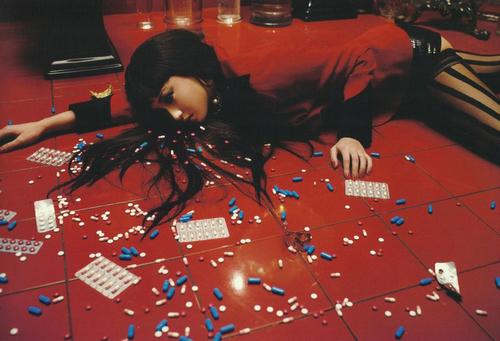
Ririko is also nymphomaniac which clearly shows how emotionally troubled she is. She seems to forget her problems and fears with sexual pleasure. However, she takes this as far as messing with her manager’s feelings by making love to her boyfriend in front of her when her fiancé rejects her. She also manipulates them to throw acid on another model’s face and gives them drugs to indulge in intercourse with her presence. She bullies and sexually harasses her manager as well. She has no limits or manners because of her unstable mental issues. Ironically, Ririko becomes uglier even though she is chasing beauty. Her choice of actions and words makes her an appalling and vicious character. Indeed, she is dark and villainous which makes her ugly but she is probably not aware of this fact as she strongly believes that only outer beauty is going to get her to where she wants. Her delusional and limited definition of beauty is actually dangerous in that it led her to addictions like sex and drugs and to commit crimes.
All she does is stare at herself in the mirror to enjoy her beautiful body and face but once she notices a mark on her forehead, she undergoes an emotional outburst and cries out of frustration and fear. This is echoed in her monologue: “If I stop being pretty, if I stop being popular, then they’ll all leave me, they’ll laugh, they’ll all forget me.” This is a thought process showing an extremely unhealthy mindset. She does not love herself the way she is; thus, she expects others to love her only if she is pretty from the outside. She is crippled with anxiety so as to satisfy others’ desires. She is also too dependent on others as she calls her boss “mama“ and seems to rely on her too much that she even took orders from her to have an affair with the producer. She is dependent on her manager as well who states that “Ririko cannot do anything without [her].”
Ririko starts to collapse when the new model Kozue shows up. As a reaction, her boss injects her to let her sleep when she sobs and complains how she feels unwanted and unloved. She is then shown on the ground with a bunch of tablets and pills like in the picture above. Therefore, Kozue’s appearance is undoubtedly disturbing for Ririko as she represents a threat to her. She is now her rival and can even beat her to the top and that frightens the main character as she knows she can easily be replaced and forgotten in this type of job. Her addictive drug use drives her to hallucinate until she collapses in a live TV show. She goes hysterical and then faints while repeatedly mumbling the phrase “more beautiful” indicating her obsession with beauty and the danger of chasing it at the cost of her own mental health.
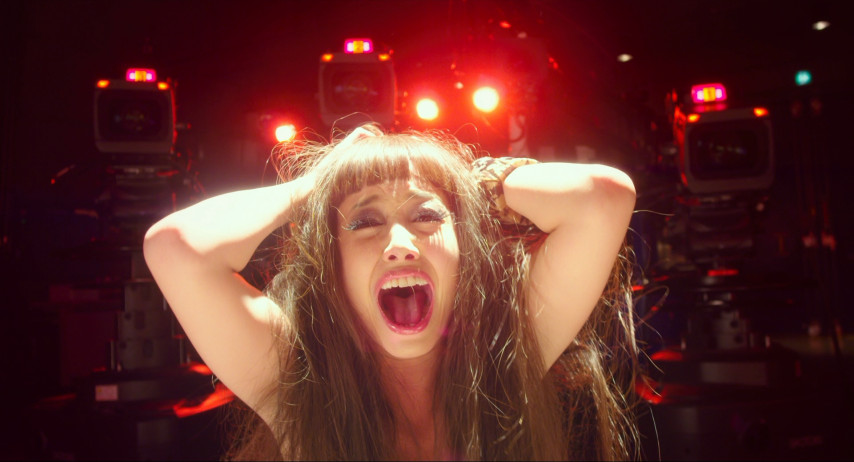
Ririko’s negative behavior escalates and reaches the peak during a press conference in which she stabs her own eye. This is a strange scene but it is very meaningful especially when she falls while red feathers gently drop on her white dress that gets tainted with the blood of her eye. Ririko’s message is that she is ready to go as far as excruciatingly harming herself to remain as “powerful” as she has always been. She defies the media and her fans that she will never allow herself to fall apart. Her time is over in this scene but she succeeded in making herself an unforgettable case with her bizarre and shocking reaction to her loss. Ririko has been going through a lot of pain to be beautiful. Even the cosmetic surgery scene seemed so painful and her doctor said that she endured worse than that. She is indeed prepared to suffer for the sake of having a beautiful body and shows this publicly to the world at the end. This scene perfectly answers the question of the poster “how far will you go for beauty?”
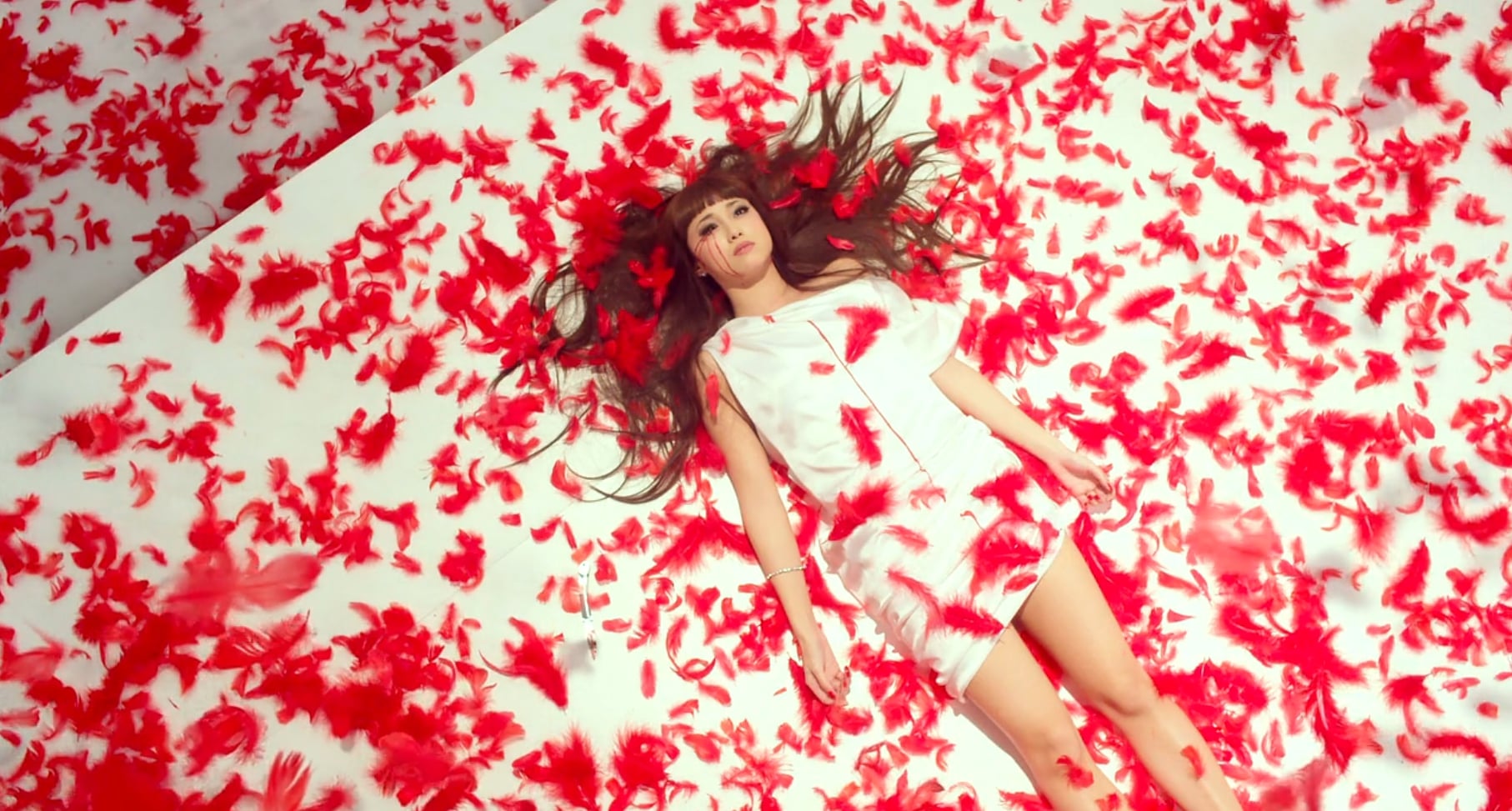
Ririko signifies the witch in the famous story of Snow White. She is vicious, insecure, and jealous. In fact, when she stares at herself in the mirror, she mutters to herself these famous lines “mirror, mirror on the wall, who is the fairest of them all?” which further accounts for her narcissistic character. Even after abusing her manager for not having ruined Kozue’s face, she runs away and when she finds the showcase in which there is a clock and what looks like dead butterflies scattered on the ground, she also faces a mirror and asks again “who’s the fairest of them all?” Therefore, Ririko is a desperate character depicting humans’ selfish needs, impulses, and urges. For this reason, Ririko stands for the id according to Freudian psychoanalytic theory of personality.
How about the other characters?
Kozue or Snow White
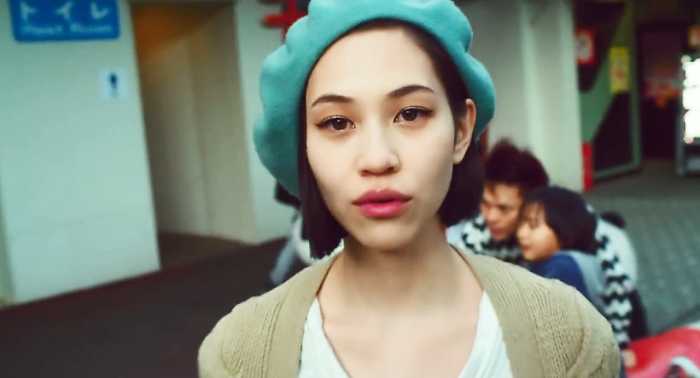
To begin with Kozue, she represents the character of Snow White as she looks whiter than Ririko and gets to compete with her which leads her to become her rival who gains even more attention than Ririko. During the police investigation, Kozue is also interviewed and proclaims “the fame, the money… I couldn’t care less.” This is a striking indication that, unlike Ririko, she is not attached to the fame and money she gets through her beauty. There is nothing shown about Kozue’s past but she is most probably only doing this job to gain a living and simply thinks that her naturally beautiful body can get her to be a model.
In another scene in which she was done with her work and the manager appears to slash her face, Kozue tells her that she does not mind and that she can go ahead and ruin her face. She justifies this through the utterance: “we’ll be forgotten. We’re machines for the processing of desires.” This entails that she is aware that physical beauty is temporary and that the modeling industry can easily replace people because it only cares about satisfying desires through outer beauty. Thus, once a model no longer fits the beauty standards that the industry and society as a whole dictate, they get forgotten and substituted like appliances or like Kozue has put it “machines.” This is the reality that Ririko refuses to handle which brings her to dark outcomes.
The boss or the super-ego
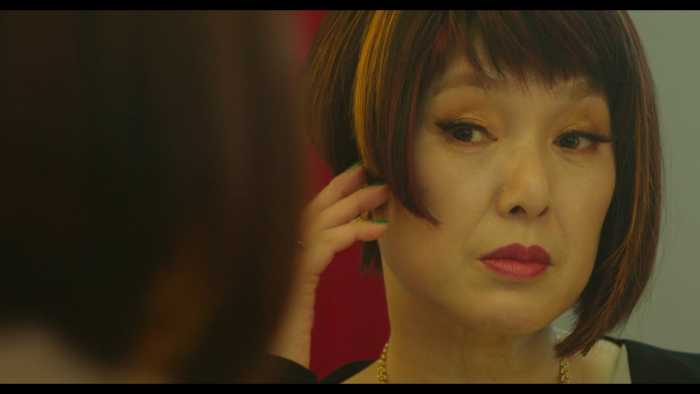
The boss cares a lot about running her business that she suggests to hire the detective to be an actor. During the police questioning, she is shown a picture of her young self that looks a lot like Ririko. This is why she told Ririko before that she does not see her as only business. She thinks her “dream” came true when she chose to preserve her beauty through Ririko. She tends to calm down Ririko’s urges and fears with injections as she wants her to keep fitting the beauty features she created for her. Just like Ririko symbolizes the id, the boss stands for the super ego that bosses around to maintain its own morals and definition of beauty. This is probably why she is the boss, and she criticizes and yells at Hada the manager, i.e. the ego, when this latter does not do her job properly.
The manager or the ego
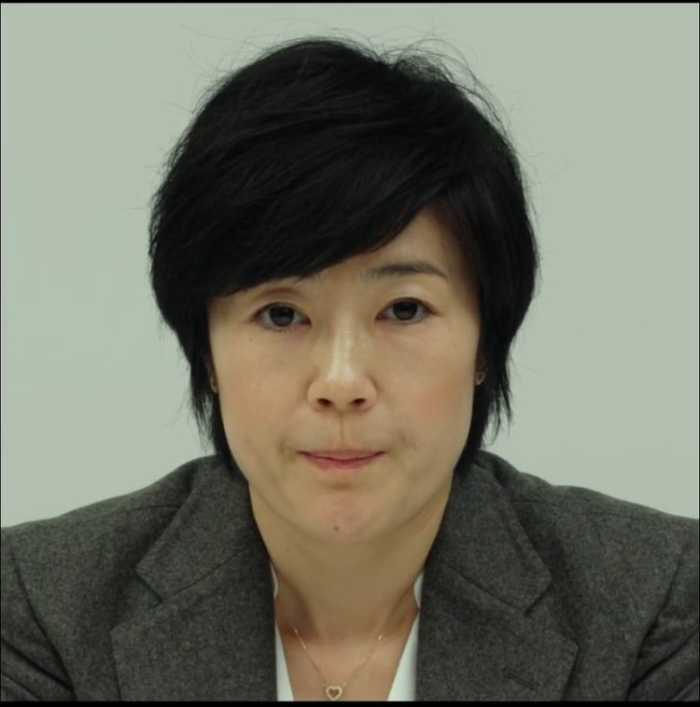
The manager Hada seems like someone who feels that she can only be loved by letting people do whatever they want with her life including her boyfriend and Ririko as they both rely on her excessively. She gives money to her boyfriend who seems like he does not do anything and is the prey of Ririko’s abusive behavior. As mentioned previously, she also gets yelled at by her boss. The manager can thus be the ego as she is torn between the id, i.e. Ririko and the super-ego, i.e. the boss. An important scene showcasing this split is when Hada is threatened by her boss if she “messes” again and is then bullied and harassed by Ririko. This is probably why she plays the role of the manager since she struggles to manage the two Freudian components of the self or human psychological identity.
The journalists, the school girls, and Ririko’s sister or society
These may be minor characters that appear quickly in the movie but their presence is significant in that it stands for society that has a huge influence on Ririko’s perception of beauty. There is a scene in which the journalists, for example, are at her door house and want to interview her about the full-body cosmetic surgery. The school girls gossip about her fake body and harshly criticize her previous appearance suggesting how society is judgemental and people, particularly celebrities and women, are constantly under pressure to follow specific beauty standards. Ririko’s sister, on the other hand, looks like the old version of Ririko herself in that she does not fit the cultural beauty criteria but she is still part of society. This is justified when the detective coincidentally meets her in the street with his assistant at the end of the film. She also underwent a cosmetic surgery and changed herself into someone conforming to social beauty standards. For this reason, she also supports the ideology that outer beauty is more important than it is supposed to be.


The detective and his assistant or the Higher Self
These two characters signify the Higher Self because they question and analyze Ririko’s behavior from a philosophical standpoint. The detective, in particular, has a critical view on the way beauty is socially perceived. In fact, his job is to investigate cases objectively which entails that his role is to critique Ririko and her likes as well as the social norms of beauty especially in the modeling context. He puts into question their endeavor to maintain a beautiful body and overlooking inner beauty that is the essence of real happiness, which invites a spiritual definition of beauty.
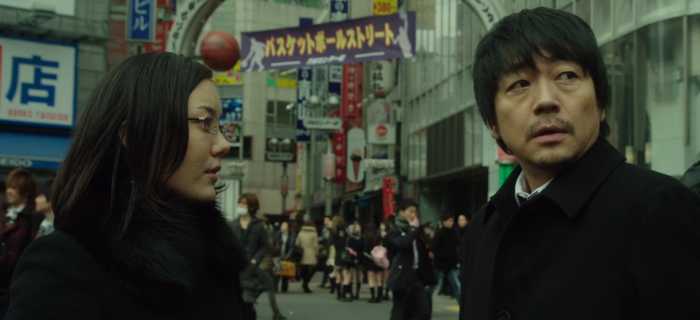
His assistant backs up his claims and her role is to ask questions that lie dormant in the depths of the subconscious mind. For example, at the end of the movie, she asks him why we are given beauty and youth and then we lose them eventually. The detective gives her a meaningful answer that makes the audience realize the real definition of beauty. He replies: “They’re not the same. Youth is beautiful but beauty isn’t youth. It’s more complicated, packed full of other things.” This is an eye-opening proclamation debunking the social belief that beauty and youth are similar, while in reality, beauty is a multidimensional concept that cannot be defined only through youth or particular beauty standards. This is a very limiting and dangerous belief driving many people to serious self-esteem problems and fears. This is the trap that Ririko falls in and many people in reality go down the same path. Ririko is a mere representation of human fears and desires in relation to physical beauty. Therefore, we get to see our own fears and desires through Ririko herself.
Accordingly, all the characters put altogether symbolize human identity and its perception of beauty. They all construct the complexity of human desires, fears, wisdom, morals, etc., in relation to beauty standards that are imposed by the society to which they are part of.
The encounter between the lowest and highest parts of human identity: Ririko vs. the detective
At first, the detective sees Ririko from afar through the screen, which indicates that she, i.e. the id, has been disconnected from her Higher Self. Then, there is a scene in which she meets him in the aquarium. In spiritual views, the abundance of water in this place symbolizes an overflow of emotions and the blue color stands for the state of calmness and serenity that the detective feels. This means that Ririko is now facing her Higher Self to deal with her real emotions that she still persistently refuses to handle.
In the final scene of her with the detective, he is sitting across her in an auditorium and she stands opposite his seat that is slightly abover her position. This superior position reinforces the fact he embodies the Higher Self. This scene is also remarkable in terms of the red color that symbolizes Ririko’s situation this time, which is that of danger. The conversation she has with him in this scene is very interesting. The detective, i.e. the Higher Self, invites her to stop flapping her wings for others. In other words, he wants her to cease hurting herself for the sake of people’s attention who are forgetful beings as they have their own concerns. Her reaction to his words reveals that she is bravely facing this part of herself but she is still obstinate by maintaining her beliefs about beauty. In fact, she replies: “there’s no one who loves me, no one who needs me, so I decide and destroy myself.” That is exactly what she did after this conversation by stabbing her eye during the press conference. This is the climax of Ririko’s fears of losing her beauty and others’ attention and temporary love.
The contrast of the color black and white in the outfits of Ririko and the detective Asada also reveals their binarity. Ririko is wearing a white dress and white high heels while Asada is wearing a black suit. This alludes to how they are complete opposites that complement each other to create the impression of a dynamic and complex human identity.
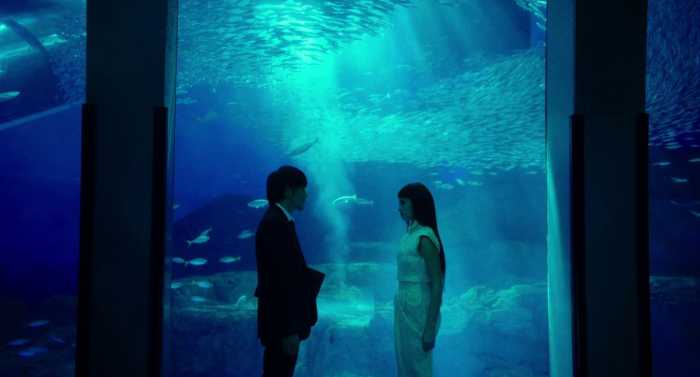
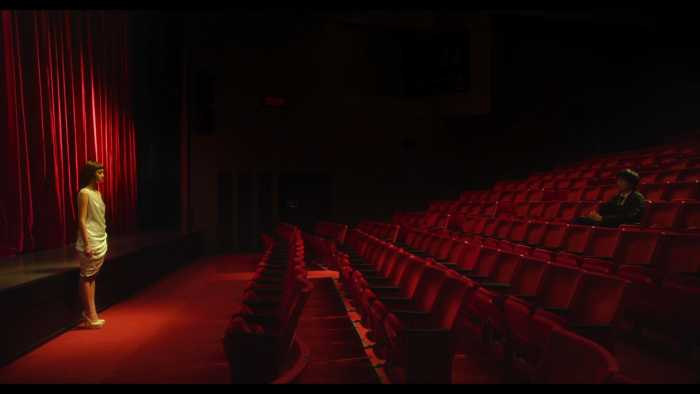
The concept of beauty in Helter Skelter
When Ririko meets her sister, she tells her to get prettier and that beauty will make her stronger. This implies that physical beauty is associated with strength and happiness. it is also connected to youth as indicated by the assistant at the end of the film. These are social judgements about the meaning of beauty driving insecure people to insanity. What is wrong with this thought process is that strength, happiness, and beauty are multifaceted concepts that connote different meanings. Beauty is not strictly limited to these definitions, but Ririko thinks without youth and physical beauty, there is no happiness or strength even though she feels unhappy deep down just like her manager proclaimed. In this context, the assistant clarifies this approach to beauty through her statement: “it’s certainly convenient to be pretty but beauty is different from happiness.” Overall, Helter Skelter is a heavily symoblic film with multimodal elements that are semiotically analyzable as most of these elements or signs stand for abstract ideas about the dark side of beauty.
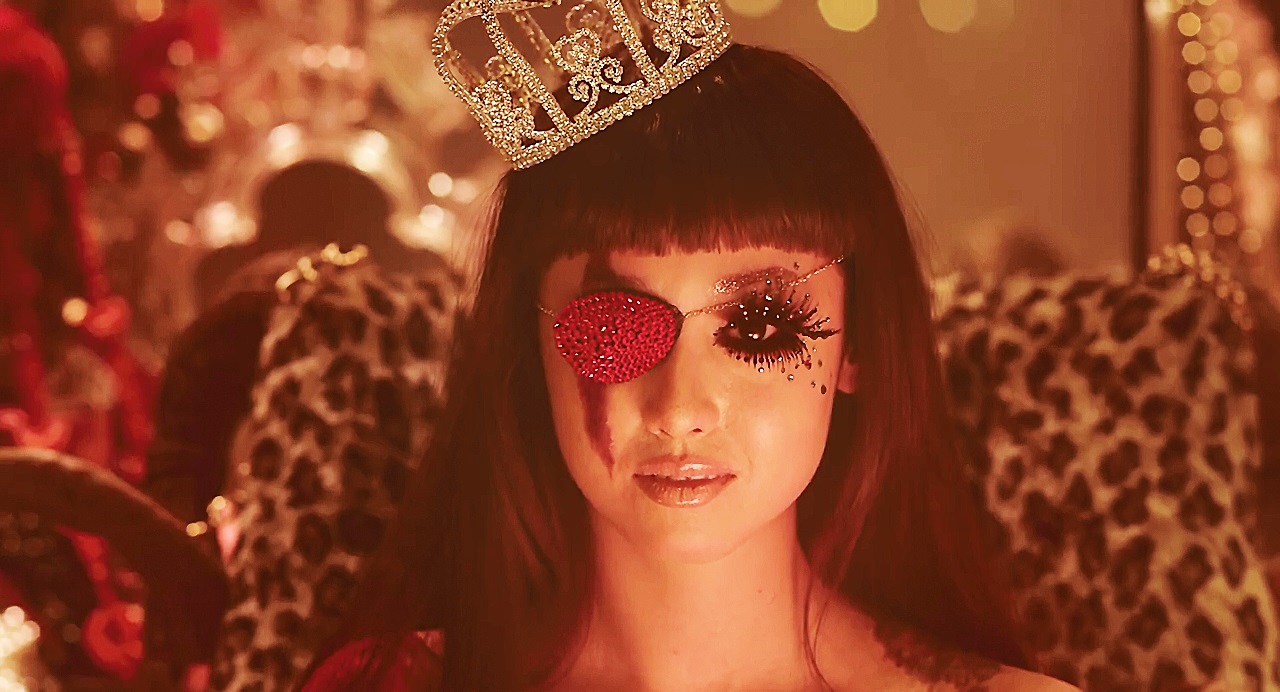
Beyond the film Helter Skelter: exploring the theme of beauty and the lesson we need to learn about it
The great philosophical debate of beauty lies in whether it is subjective or objective. It has long been assumed that beauty “lies in the eye of the beholder” meaning that it is subjective and the perceiver judges whether something or someone is beautiful or not. Kant advocates this idea of beauty being subjective. He alleges in his Critique of Judgement that “the judgment of taste is therefore not a judgment of cognition, and is consequently not logical but aesthetical, by which we understand that whose determining ground can be no other than subjective.” Hume reinforces this idea of beauty and stresses that “it exists merely in the mind which contemplates them.” Yet, if beauty is subjective, then it can lose its meaning as it does not have a shared definition according to this view. The opposite is true in that making beauty objective sounds far-fetched and makes it seem like it is measurable with scientific experiments. 5 The notion of beauty, therefore, is complex and can be perceived from multiple angles including artistic, philosophical, and sociocultural ones. It can also be both objective and subjective in that one can explore all the possible definitions attributed to it and choose the one that seems meaningful for them.
This movie unveils an unspoken reality of the darkness that beauty standards imply especially in modern society with the omnipresence of social media and online modeling. People, particularly women, feel under pressure to fit certain beauty criteria and to look a certain way. Ririko is an embodiment of the despair all these women feel inside and are not showing to the world. We are all desperate to achieve and preserve something in life. This can be beauty, success, fame, money, love, stability, family, and the list goes on. However, achieving something to fulfill the desires of society and prioritizing those desires to exceed inner ones, or making those desires too important to an extreme degree is certainly not a healthy way of thinking of those desires. This way, they are no longer calm and serene desires but extreme attachments. As Roger Walsh has put it “happiness lies not in feeding and fueling our attachments, but in reducing and relinquishing them.” 6 There is nothing wrong with striving to fulfill desires but it needs to be done cautiously without damaging one’s physical and mental health. Prioritizing health over those desires is certainly a wise choice and bringing awareness to the fact they are temporary is required to have a balanced and happy lifestyle.
Works Cited
- Yakin, H.S.M., & Totu, A. (2014, October 18-20). The Semiotic Perspectives of Peirce and Saussure: A Brief Comparative Study [paper presentation]. The International Conference on Communication and Media 2014 (i-COME’14), Langkawi, Malaysia. https://www.sciencedirect.com/science/article/pii/S1877042814057139 ↩
- Anon (2017, March 5). Semiotics. Annie’s Blog. https://anniehaydesign.weebly.com/colour-is-sound/semiotics ↩
- Anon. (n.d.). https://silo.tips/download/chapter-2-semiotics-of-films ↩
- Fusco, J. (2016). The Psychology of Color in Film (with examples). No Film School. https://nofilmschool.com/2016/06/watch-psychology-color-film ↩
- Sartwell, C. (2012). Beauty. In Stanford Encyclopedia of Philosophy. Retrieved October 5, 2016, from https://plato.stanford.edu/entries/beauty/#ObjSub ↩
- Walsh, R. (1999). Essential Spirituality: Exercices from the world’s religions to cultivate kindness, love, joy, peace, vision, wisdom, and generosity. John Wiley & Sons. ↩
What do you think? Leave a comment.











This should be compulsory reading for Instagram influencers.
Great analysis. I like the film but I think it would have been stronger to focus on just Lilico’s struggle with relevance instead of trying all these B-plots that don’t really go anywhere.
They serve to describe Ririko’s struggles though.
Agree. There was a natural ending point that I thought was pretty hard-hitting and could have said some pretty interesting things about fame and beauty, but instead opted to go on for another 20 minutes with the typical Japanese movie nonsense imagery that I should have expected.
This is basically a Japanese giallo movie and it’s possibly one of the best examples of giallo I’ve ever seen, though right now that’s not saying much.
One of the most packed movies I have ever seen visually.
One of the few movies movies where i think the sex scenes actually served to benefit the film. was very visually beautiful and i think captivated the feelings of everything so well. lilico was such an interesting character and it really captured her dissent into madness in a way that spoke 2 me i think. even w the manipulation that took place like u can see the desperation and how she really wasn’t thinking straight idk she was such a well written character i think.
I agree! She is a very interesting and unforgettable character.
The last 30 mins of this movie were truly something else.
The price of pretty is never worth it, but the cycle repeats again and again and again. it’s not about actual beauty, it’s about chasing this unattainable yet ever changing standard of “perfect”, it’s sad because these girls are aware it won’t last.
I’ve been a fan of Mika Nanigawa’s photographic work for years, and even own the photo book for this movie. Color me happy when I say an article about it on my favorite digital magazine.
Interesting coverage of objects and what they can symbolize. Good job!
Thank you!
I love movie genre centred around women’s obsession with beauty and the madness that surrounds the entire concept.
Ah helter skelter portrayed all of this perfectly — the need to look perfect versus the sinking dread when you are eventually forgotten and replaced by someone else.
Amazing film!
I really wish a second movie with a love story between lilico and kozue.
I tend to like darker films and I think this story could’ve been a lot darker at times, but it was a fun mix of horror and maniacal comedy. The plot is ironic considering it was about how vapid society is especially with celebrity worship and this film could certainly be considered bombastic to some on the contrary but maybe that’s the metaphor the director was going for.
Read this. Watch it. Craziest movie i’ve watched in a while holy hell i love it.
This movie makes me go clinically legally insane it speaks to me.
The manga too!
Women often go through absurd lengths to attain the unrealistic standards imposed by the patriarchy in the hopes of being treated as valuable and worthy of being seen and heard. In return, the very same patriarchy crucify women for succumbing to their demands.
In Lilico’s downfall and self-destruction, she is still viewed as a commodity of entertainment. Even as Lilico stabbed her eyes with the knife, the camera flashes continued. The audience, consisted of purely men, remained unfazed. Lilico became the new topic of gossips; her existence made as a precautionary tale. This is the reality for women. And just like how Kozue replaced Lilico, the cycle will always repeat. “Desire doesn’t care. It just keeps on with another name and another face.”
It’s like the joker but for women.
This movie blew me away. I want to say something more meaningful but I’m at a loss for words at the moment.
All I know is that the scene where she gouges her eye out, shocking the audience for a moment only for them to go back to taking photos of her as she literally cried blood will stick with me.
Truly incredible filmmaking here and it’s a shame it’s not that well known when it totally deserves to be. AT least there are people like you covering it. THANK YOU.
Thank YOU! That scene will forever stick with me too. I agree that more people need to watch this movie. It’s beautifully made and heavily symbolic.
Felt like the narrative was a bit too aimless and dragged a bit.
Very dysmorphia vibes!
Probably the most visually pleasing movie i have ever seen, the aesthetics are unmatched, and i have not seen anything like this before.
Totally!
Social criticism badassery!
Watching it kinda made me want a cigarette.
I would probably hate this film if it was American.
It isn’t exactly a horror film, although it does have characteristics of the genre. I loved the magnificent colors, visual aesthetics, shot selection, art direction, and exquisite fashion.
I feel like I should’ve liked this movie a lot more than I actually did. And I think, if I watched this movie almost ten years ago when it first came out, I probably would’ve. But I really struggled to really maintain any interest in it — it seemed especially promising at times, evoking memories of Perfect Blue, but it ultimately just seemed to fall short.
This movie is more than a masterpiece, and erika sawajiri acting is so good.
I love the underlying messages, about vanity and the unrealistic pursuit of perfection. This movie holds back on nothing, no detail is spared no matter how lewd or gruesome.
Black Swan origin story.
i think the eclectic maximalism of ninagawa is like, immediately, not what okazaki is doing with the manga, but that’s fine, and i don’t think that sort of liberal interpretative stance doesn’t work. but it doesn’t really work on the whole.
I love mika ninagawa’s style of cinematography and photography. i’m so obsessed with her.
A reminder to us all that beauty is disposable, that constantly chasing it won’t bring us joy neither fulfill ourselves, but most importantly, beauty can also be horrific.
I applaud your level of detail, and especially appreciate the discussion of semiotics, codes, and film semiotics.
Thank you!
I love the fact the main actress was arrested years later for having lsd and now she’s coming back to film industry… it’s like helter skelter 2
See what happens when celebrity women breakdown movies like the neon demon or antiporno are directed by women?!!? they become the joker for hot girls! Also opening sequence was chef’s kiss.
So real!
This is my favourite movie of all time I don’t care what anybody else thinks.
I feel bad for hada.
Has one of the best opening scenes ever. Reminds me of a certain photographer.
Sometimes films fail to accomplish the perfect balance between good visuals and good writing. This is a good example of that.
It’s a very pretty film about a very empty world.
I would take a bullet for Hada no questions asked.
She’s my joker now.